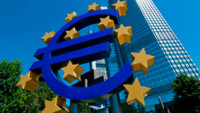 European markets saw a much more positive session yesterday, carrying over the momentum from a buoyant US market, but also getting a lift after China announced a 0.5% cut in the bank reserve requirement rate from 5th February.
European markets saw a much more positive session yesterday, carrying over the momentum from a buoyant US market, but also getting a lift after China announced a 0.5% cut in the bank reserve requirement rate from 5th February.
US markets finished the day mixed with the Dow finishing lower for the 2nd day in succession, while the S&P500 and Nasdaq 100 once again set new record highs, as well as record closes, although closing off the highs of the day as yields edged into positive territory.
This divergence between the Dow and Russell 2000, both of which closed lower for the second day in succession, and the Nasdaq 100 and S&P500 might be a cause for concern, given how US market gains appear to be being driven by a small cohort of companies share prices.
Today’s focus for European markets which are set to open slightly lower, is on the ECB and the press conference later with Christine Lagarde, where apart from questions on time lines about possible rate policy, Lagarde could face some questions a little closer to home amidst dissatisfaction over her leadership style from ECB staffers.
When looking at the economic performance of the euro area, we’ve seen little in the way of growth since Q3 of 2022, while inflation has also been slowing sharply. Yet for all this economic weakness, a fact which was borne out by yesterday’s flash PMI numbers, especially in the services sector, the ECB has been insistent it is not close to considering a cut in rates, having hiked as recently as last September.
Only as recently as last week we heard from a few governing council members of their concerns about cutting too early, yet when looking at the data, and the fact that the German economy is on its knees, the ECB almost comes across as masochistic in its desire to combat the risks of a return of inflation.
In a way it’s not hard to understand given that after November headline inflation slowed to 2.4%, it picked up again in December to 2.9%, while core prices slowed to 3.4%.
This rebound in headline inflation while no doubt driven by base effects will be used as evidence from the hawks on the governing council that rates need to stay high, however there is already evidence that the consensus on rates is splintering, and while no more rate hikes are expected the economic data increasingly supports the idea of a cut sooner rather than later.
Markets currently have the ECB cutting rates 4 times this year in increments of 25bps, starting in June, although given the data we could get one in April.
This contrasts with the market pricing up to 6 rate cuts from the Federal Reserve despite the US economy being magnitudes stronger than in Europe.
No changes are expected today with the main ECB refinancing rate currently at 4.5%, however Q4 GDP due next week, and January CPI due on 1st February calls for a March/April rate cut could start to get louder in the weeks ahead, especially since PPI has been in deflation for the last 6 months.
US bond markets appear to be starting to have second thoughts about the prospect of 6 rate cuts from the Federal Reserve this year, although there is still some insistence that a March cut remains a realistic possibility.
Today’s US Q4 GDP numbers might bury the prospect of that idea once and for all if we get a reading anywhere close to 2%.
This seems rather counterintuitive when you think about it, the idea that the Fed would cut before the ECB when Europe is probably in recession and the US economy is growing at a reasonable rate, albeit at a slower pace than in Q3.
Expectations for Q4 are for the economy to have slowed to an annualised 1.9% to 2%, which would be either be the weakest quarter of 2023 or match it.
Nonetheless the resilience of the US consumer has been at the forefront of the rebound in US growth seen over the past 12 months, with a strong end to the year for consumer spending. This rather jars against the idea that US GDP growth might get revised lower in the coming weeks as some have been insisting. If you look at the December control group retail sales numbers, they finished the year strongly and these numbers get included as a part of overall GDP
Weekly jobless claims are also at multi-month lows of 187k, and while we could see a rise to 200k even here there is no evidence that the US economy is slowing in such a manner to suggest anything other than a modest slowdown as opposed to a sudden stop or hard landing.
The core PCE Q/Q price index is expected to slow from the 3.3% seen in Q3 to around 2%, which may not be enough to prompt a softening in yields unless we drop below 2%.
EUR/USD – pushed up to the 1.0930 area before retreating. While above the 200-day SMA at 1.0830, the bias remains for a move higher towards the main resistance up at 1.1000.
GBP/USD – pushed up towards 1.2775 yesterday with support at the 50-day SMA as well as the 1.2590 area needed to hold or risk a move lower towards the 200-day SMA at 1.2540. We need to get above 1.2800 to maintain upside momentum.
EUR/GBP – fell to 0.8535 before rebounding modestly. Also have support at the 0.8520 area, with resistance at the 0.8620/25 area and the highs last week.
USD/JPY – finding a few offers at the 148.80 area over the last 3days which could see a move back towards the 146.25 area. A fall through 146.00 could delay a move towards 150 and argue for a move towards 144.00.












